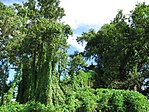| Revision as of 15:06, 10 September 2024 edit2405:201:900e:48c0:f82c:6553:3fd3:cff2 (talk) →SchoolsTags: Mobile edit Mobile web edit← Previous edit | Revision as of 15:35, 10 September 2024 edit undoBruce1ee (talk | contribs)Autopatrolled, Extended confirmed users, Pending changes reviewers, Rollbackers269,973 editsm fixed lint errors – missing end tagNext edit → | ||
| Line 451: | Line 451: | ||
| * Khantura Boys High School, Gobardanga | * Khantura Boys High School, Gobardanga | ||
| * Khantura Girls High School, Gobardanga | * Khantura Girls High School, Gobardanga | ||
| {{div col end}} | |||
| ==Culture== | ==Culture== | ||
Revision as of 15:35, 10 September 2024
District in West Bengal, India| This article needs additional citations for verification. Please help improve this article by adding citations to reliable sources. Unsourced material may be challenged and removed. Find sources: "North 24 Parganas district" – news · newspapers · books · scholar · JSTOR (September 2022) (Learn how and when to remove this message) |
District in West Bengal, India
North 24 Parganas (abv. 24 PGS (N)) or sometimes North Twenty Four Parganas is a district in southern West Bengal, of eastern India. North 24 Parganas extends in the tropical zone from latitude 22° 11′ 6″ north to 23° 15′ 2″ north and from longitude 88º20' east to 89º5' east. Barasat is the district headquarters of North 24 Parganas. North 24 Parganas is West Bengal's most populous district and also (since 2014) the most populated district in the whole of India. It is the tenth-largest district in the State by area.
History
Pre-independence
The territory of Greater 24 Parganas were under the Satgaon (ancient Saptagram, now in Hoogly district) administration during the Mughal era and later it was included in Hoogly chakla (district under post-Mughal Nawabi rule) during the rule of Murshid Quli Khan. In 1757, after the Battle of Plassey, Nawab Mir Jafar conferred the Zamindari of 24 parganas and janglimahals (small administrative units) upon the British East India Company. These Parganas are: 1. Akbarpur, 2. Amirpur, 3. Asimabad, 4. Balia, 5. Baridhati, 6. Basandhari, 7. Birati, 8. Calcutta, 9. Dakshin Sagar, 10. Garh, 11. Hathiagarh, 12. Ikhtiarpur, 13. Kharijuri, 14. Khaspur, 15. Maidanmal or Mednimall, 16. Magura, 17. Mayda, 18. Manpur, 19. Murnagacha, 20. Paika, 21. Pechakul, 22. Satal, 23. Shahnagar, 24. Shahpur, and 25. Uttar Pargana (O'Mally, L.S.S. (1914) Bengal District Gazetteers: 24 Parganas. Page 44). Since then, this entire territory is known as '24 Parganas'.
In 1751, the Company assigned John Zephaniah Holwell as zemindar of the District. In 1759, after the Bengali War of 1756–1757, the Company assigned it to Lord Clive as a personal Jaghir (zamindari) and after his death it again came under the direct authority of the company.
In 1793, during the rule of Lord Cornwallis, entire Sunderbans were in Twentyfour Parganas. In 1802, some parganas on the western banks of river Hoogly were included into it. These parganas were in Nadia earlier. In 1814, a separate collectorate was established in Twenty-four Parganas. In 1817, Falta and Baranagar and in 1820, some portions of Nadia's Balanda and Anwarpur were encompassed to it. In 1824, portions of Barasat, Khulna and Bakhargunge (now in Bangladesh) were also included to it. In 1824, the district headquarters was shifted from Kolkata to Baruipur, but in 1828, it was removed to Alipore. In 1834, the district was split into two districts – Alipore and Barasat, but later these were united again.
In 1905, some portion of this district around the Sunderbans was detached and linked to Khulna and Barishal. These parts remained in Bangladesh territories where Jessore's Bangaon was joined to Twentyfour Pargana after the 1947 partition.
After Independence
In 1980, an administrative reform committee under the chairmanship of Dr. Ashok Mitra suggested splitting the district into two and as per the recommendation of the committee in 1983, on 1 March 1986, two new districts – North 24 Parganas (24 PGS (N)) and South 24 Parganas (24 PGS (S)) were created. The North 24 Parganas which was included in the Presidency division has been formed with five sub-divisions of the Greater 24 Parganas, namely Barasat Sadar (Headquarters), Barrackpore, Basirhat, Bangaon, and Bidhannagar (a satellite township of Kolkata, popularly known as Salt Lake).
On 1 August 2022, the Chief Minister of West Bengal Mamata Banerjee announced to create two more districts named Ichamati district consisting of Bangaon subdivision and a yet unnamed district consisting of Basirhat subdivision by bifurcating the district for better development and smooth administration purpose.
Geography
The district lies within the Ganga–Brahmaputra delta. The major distributary of river Ganga that is river Hooghly flows along the western border of the district. There are many other distributary branches, sub-branches of Ganga river and other local rivers, which include the Ichhamati, Jamuna, and Bidyadhari.
Economy
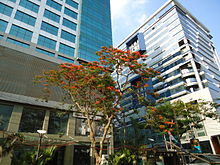


People are mainly engaged in farming, fishing and other agricultural activities. The average size of agricultural landholdings is about 3.2 Bighas. North 24 Parganas is one of the economically developed districts of West Bengal, but there is chronic poverty in the southern half of the district (the Sundarbans area).
The information technology hub of Kolkata is at this district, which is the centre of some of the notable IT/ITES Indian and multinational companies. Approximately 1,500 companies have their offices in Sector V. Majority of the corporate offices are situated in Sector V and Sector III. Around 3.5 Lakh (by 2017) people are employed in Salt Lake City.
Divisions
Administrative subdivisions

The district comprises five subdivisions: Barrackpore, Barasat Sadar, Basirhat, Bangaon and Bidhannagar.
- Barrackpore Subdivision consists of 16 municipalities (Kanchrapara, Halisahar, Naihati, Bhatpara, Garulia, Barrackpore, North Barrackpur, New Barrackpur, Titagarh, Khardaha, Panihati, Kamarhati, Baranagar, Dum Dum, North Dumdum and South Dumdum (25 Wards)) and 2 community development blocks: Barrackpore I and Barrackpore II.
- Barasat Sadar Subdivision consists of five municipalities (Barasat, Habra, Ashoknagar Kalyangarh, Madhyamgram, and Gobardanga) and 7 community development blocks: Barasat I, Barasat II, Amdanga, Deganga, Habra I and Habra II
- Bongaon Subdivision, consists of Bangaon municipality and three community development blocks: Bagdah, Bangaon and Gaighata.
- Basirhat Subdivision consists of three municipalities (Basirhat, Baduria and Taki) and ten community development blocks: Baduria, Basirhat I, Basirhat II, Haroa, Hasnabad, Hingalganj, Minakhan, Sandeshkhali I, Sandeshkhali II, Swarupnagar.
- Bidhannagar Subdivision consists of Bidhannagar Municipal Corporation,South Dum Dum Municipality (10 wards) and one community development blocks Rajarhat.
Barasat is the district headquarters. There are 35 police stations, 22 development blocks, 27 municipalities, 200 gram panchayats and 1599 villages in this district.
Other than municipality area, each subdivision contains community development blocks which in turn are divided into rural areas and census towns. In total there are 48 urban units: 27 municipalities and 20 census towns and 1 cantonment board.
Barrackpore subdivision
- 16 municipalities: Kanchrapara, Halisahar, Naihati, Bhatpara, Garulia, Barrackpore, North Barrackpur, New Barrackpur, Titagarh, Khardaha, Panihati, Kamarhati, Baranagar, Dum Dum, North Dumdum and South Dumdum.
- One Cantonment Board: Barrackpur Cantonment.
- One more census town: Ichhapur Defence Estate.
- Barrackpore I (Community development block) consists of rural areas with 8 gram panchayats and three census towns: Jetia, Garshyamnagar and Kaugachhi.
- Barrackpore II (Community development block) consists of rural areas with 6 gram panchayats and six census towns: Jafarpur, Talbandha, Muragachha, Patulia, Ruiya and Chandpur.
- Panchayet: Duttapukur
Barasat Sadar subdivision
- 5 municipalities: Barasat, Habra, Ashoknagar Kalyangarh, Madhyamgram and Gobardanga.
- Barasat I (Community development block) consists of rural areas with 9 gram panchayats and 1 census town: Duttapukur.
- Barasat II (Community development block) consists of rural areas only with 7 gram panchayats.
- Amdanga (Community development block) consists of rural areas only with 8 gram panchayats.
- Deganga (Community development block) consists of rural areas only with 13 gram panchayats.
- Habra I (Community development block) consists of rural areas with 7 gram panchayats and 3 census towns: Nokpul, Maslandapur and Sadpur.
- Habra II (Community development block) consists of rural areas with 8 gram panchayats and 2 census towns: Bara Bamonia and Guma.
- Rajarhat (Community development block) (now shifted to Bidhannagar Subdivision) consists of rural areas with 6 gram panchayats (after Mahishbathan II gram panchayat being shifted to Bidhannagar Municipal Corporation, number of gram panchayats becomes 5) and 1 census town: Raigachhi.
Bangaon subdivision
- 1 municipality: Bangaon.
- Bagdah (Community development block) consists of rural areas only with 9 gram panchayats.
- Bangaon (Community development block) consists of rural areas only with 16 gram panchayats.
- Gaighata (Community development block) consists of rural areas with 13 gram panchayats and seven census towns: Chandpara(7,113), Chhekati (4,995), Sonatikiri (6,919), Dhakuria (10,165), Chikanpara (9,594), Shimulpur (20,803) and Bara (5,172).
Basirhat subdivision
- Three municipalities: Basirhat, Baduria and Taki.
- Baduria (Community development block) consists of rural areas only with 14 gram panchayats.
- Basirhat I (Community development block) consists of rural areas only with 7 gram panchayats.
- Basirhat II (Community development block) consists of rural areas with 9 gram panchayats and one census town: Dhanyakuria.
- Haroa (Community development block) consists of rural areas only with 8 gram panchayats.
- Hasnabad (Community development block) consists of rural areas only with 9 gram panchayats.
- Hingalganj (Community development block) consists of rural areas only with 9 gram panchayats.
- Minakhan (Community development block) consists of rural areas only with 8 gram panchayats.
- Sandeshkhali I (Community development block) consists of rural areas only with 8 gram panchayats.
- Sandeshkhali II (Community development block) consists of rural areas only with 8 gram panchayats.
- Swarupnagar (Community development block) consists of rural areas only with 10 gram panchayats.
Bidhannagar subdivision
This subdivision consists of the Bidhannagar Municipal Corporation.
- Rajarhat (Community development block) is also shifted to this subdivision now.
Assembly constituencies
As per order of the Delimitation Commission in respect of the delimitation of constituencies in the West Bengal, the district is divided into 33 assembly constituencies:
- Bagdah, Bangaon Uttar and Dakshin, Gaighata, Swarupnagar, Minakhan and Hingalganj constituencies are reserved for Scheduled Castes (SC) candidates while Sandeshkhali is reserved for Schedule Tribe (ST).
- Bagdaha, Bangaon Uttar and Dakshin, Gaighata, Swarupnagar, and Kalyani and Haringhata (two assembly constituencies from Nadia) assembly constituencies form the Bangaon (Lok Sabha constituency) which is reserved for Schedule Caste (SC) candidate.
- Habra, Ashoknagar, Rajarhat-New Town, Bidhannagar, Madhyagram, Barasat, Deganga assembly constituencies form the Barasat (Lok Sabha constituency).
- Khardaha, Dum Dum, Dum Dum Uttar, Panihati, Kamarhati, Baranagar, Rajarhat Gopalpur assembly constituencies form the Dum Dum (Lok Sabha constituency).
- Amdanga, Bijpur, Naihati, Bhatpara, Jagatdal, Noapara, Barrackpore assembly constituencies form the Barrackpore (Lok Sabha constituency).
- Baduria, Haroa, Minakhan, Sandeshkhali, Basirhat Uttar, Basirhat Dakshin, Hingalganj constituencies are part of the Basirhat (Lok Sabha constituency).
Education
This is a dynamic list and may never be able to satisfy particular standards for completeness. You can help by adding missing items with reliable sources.Universities
 Indian Statistical Institute, Baranagar
Indian Statistical Institute, Baranagar West Bengal State University, located at Barasat, the main general degree university of the district
West Bengal State University, located at Barasat, the main general degree university of the district
- Indian Statistical Institute
- Maulana Abul Kalam Azad University of Technology
- West Bengal State University
- JIS University
- Techno India University
- Brainware University
- Adamas University
- University of Calcutta (Technological Campus)
- Jadavpur University (Second Campus)
- Aliah University
- Netaji Subhas Open University
- Amity University
- Sister Nivedita University
- St. Xavier's University, Kolkata
Colleges

- Narula Institute of Technology
- Brahmananda Keshab Chandra College
- Prasanta Chandra Mahalanobis Mahavidyalaya
- Acharya Prafulla Chandra College
- Basirhat College
- College of Medicine & Sagore Dutta Hospital
- Guru Nanak Institute of Dental Sciences and Research
- Guru Nanak Institute of Technology
- Bhairab Ganguly College
- Bidhannagar College
- Ramakrishna Mission Vivekananda Centenary College
- Barasat Government College
- Barasat College
- Barrackpore Rastraguru Surendranath College
- Government College of Engineering and Leather Technology
- Gobardanga Hindu College
- Dinabandhu Mahavidyalay
- Sree Chaitanya College
- Institute of Engineering and Management
- Taki Government College
- Vivekananda College, Madhyamgram
- Guru Nanak Institute of Pharmaceutical Science and Technology
- Netaji Satabarshiki College, Ashokenagar
- Berachampa Shahidullah College
Schools

- Bagdah High School
- Baranagore Ramakrishna Mission Ashrama High School
- Barasat Indira Gandhi Memorial High School
- Central Modern School
- Sodepur High School
- St. Xavier's Institution (Panihati)
- Adamas International School
- Aditya Academy (Senior Secondary)
- Auxilium Convent School
- Barrackpore Government High School
- Berachampa Deulia Uchcha Vidyalaya
- Kendriya Vidyalaya Barrackpore (Army)
- Ramakrishna Vivekananda Mission Vidyabhavan Barrackpore
- St. Stephen's School, Habra
- Stratford Day School, Habra
- Kalyangarh Bidya Mandir, Ashokenagar
- Kalyangarh Balika Bidyamandir, Ashokenagar
- Baduria Dilip Kumar Memorial Institution(H.S.)
- Madhyamgram High School, Madhyamgram
- Madhyamgram Girls High School, Madhyamgram
- Madhyamgram Acharya Prafulla Chandra Balika Vidyalaya, Madhyamgram
- Madhyamgram Acharya Prafulla Chandra Vidyayatan, Madhyamgram
- Jadurhati adarsha vidyapith (H.S)
- Khantura Boys High School, Gobardanga
- Khantura Girls High School, Gobardanga
Culture
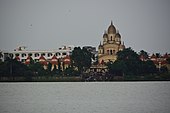

This district is rich in culture. Many famous places like Dakshineswar Kali Temple, Baranagar Math (first monastery of Ramakrishna Order) are situated in this district. Many places of this district are famous for festivals – Helencha, Maslandapur, Habra, Barrackpore, Barasat, Naihati and Madhyamgram are for Kali puja,Bangaon, Gobardanga, Baranagar, Basirhat are for Durga Puja, Ashoknagar Kalyangarh is for Jagatdhatri puja, Berachampa is for Basanti puja etc.
Transport
Railways
The electrified suburban rail network of the ER is extensive and penetrates far and deep into the neighbouring districts of Kolkata, South 24 Parganas, Nadia, Howrah, Hooghly etc.
The Circular Rail encircles the entire city of Kolkata, and also used to provide an offshoot to connect the Dum Dum Airport, but now it is limited up to Dum Dum Cantonment. Jessore Road and Biman Bandar railway stations are closed for the construction work of Noapara–Dum Dum Airport–Barasat Metro rail (Kolkata Metro Line 4).
Metro rail is also a transport medium of this district's people. Four stations of Kolkata Metro Line 1 are located here, Dum Dum metro station at Dum Dum, Baranagar metro station at Baranagar, Dakshineswar metro station at Dakshineswar and Noapara metro station at Noapara, Baranagar.
-
Kolkata Suburban EMU Train
-
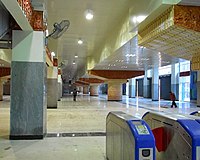 Kolkata Metro's largest station Noapara metro station at Noapara, Baranagar
Kolkata Metro's largest station Noapara metro station at Noapara, Baranagar
Airports
See also: Netaji Subhash Chandra Bose International Airport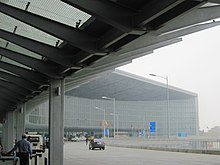
The Netaji Subhash Chandra Bose International Airport (IATA code:CCU), which is at Dum Dum (previously known as Dum Dum Airport) in North 24 Parganas, is the only airport serving the city Kolkata. It operates both domestic and international flights. It is a gateway to North-East India, Bangkok, and Bangladesh. The number of people using the airport has consistently increased over the last few years.
Roadways
The road network is fairly well developed. Sparsed across by state-highways, it provides a convenient means of transport. NH 12 connects the district with northern and southern region of the state and its sub road NH 112 connect the district headquarter Barasat with the border town Bangaon and Petrapole, the largest land port of India.
Demographics
See also: List of West Bengal districts ranked by literacy rate| Year | Pop. | ±% p.a. |
|---|---|---|
| 1901 | 1,016,001 | — |
| 1911 | 1,166,158 | +1.39% |
| 1921 | 1,239,719 | +0.61% |
| 1931 | 1,357,831 | +0.91% |
| 1941 | 1,711,806 | +2.34% |
| 1951 | 2,114,097 | +2.13% |
| 1961 | 3,127,685 | +3.99% |
| 1971 | 4,207,420 | +3.01% |
| 1981 | 5,529,497 | +2.77% |
| 1991 | 7,281,881 | +2.79% |
| 2001 | 8,934,286 | +2.07% |
| 2011 | 10,009,781 | +1.14% |
| source: | ||
According to the 2011 census North 24 Parganas district has a population of 10,009,781, roughly equal to the nation of Bolivia or the US state of Michigan. This gave it a ranking of second in India (out of a total of 640) and first in its state. However, in 2014 the Thane district (in Maharashtra), which had been ranked first in India in 2011, was divided into two, thus promoting North 24 Parganas District to first in India. The district has a population density of 2,463 inhabitants per square kilometre (6,380/sq mi). Its population growth rate over the decade 2001–2011 was 12.86%. North Twenty Four Parganas has a sex ratio of 949 females for every 1000 males, and a literacy rate of 84.95%. 57.28% of the population lives in urban areas. Scheduled Castes and Scheduled Tribes make up 21.67% and 2.64% of the population respectively.
- Population Density: 2959 per square km
- Sex ratio: 982 females per 1000 males
- Growth Rate (1991–2000): 24.64% (approximately 2.5% per annum)
- Literacy rate (excluding 0–6 age group), in percentage: 87.66 (highest in West Bengal).
- Male: 93.14; Female: 81.81
Religion
| Religion in North 24 Parganas district (2011) | ||||
|---|---|---|---|---|
| Hinduism | 73.76% | |||
| Islam | 25.52% | |||
| Other or not stated | 0.72% | |||
| Religion | Population (1941) | Percentage (1941) | Population (2011) | Percentage (2011) |
|---|---|---|---|---|
| Hinduism |
927,418 | 57.09% | 7,396,769 | 73.76% |
| Islam |
648,920 | 39.95% | 2,584,684 | 25.52% |
| Tribal religion | 41,105 | 2.53% | 2,930 | 0.03% |
| Others | 6,994 | 0.43% | 69,398 | 0.69% |
| Total Population | 1,624,437 | 100% | 10,009,781 | 100% |
| CD Block | Hindu | Muslim | Other |
|---|---|---|---|
| Bagdah | 82.00% | 17.42% | 0.58% |
| Bongaon | 78.17% | 20.83% | 1.00% |
| Gaighata | 93.27% | 6.42% | 0.31% |
| Swarupnagar | 54.85% | 45.20% | 0.25% |
| Habra I | 73.51% | 25.81% | 0.68% |
| Habra II | 53.85% | 45.76% | 0.39% |
| Amdanga | 43.30% | 56.48% | 0.22% |
| Barrackpur I | 84.38% | 14.46% | 1.15% |
| Barrackpur II | 77.71% | 21.45% | 0.84% |
| Barasat I | 57.10% | 42.08% | 0.49% |
| Barasat II | 30.05% | 69.68% | 0.26% |
| Deganga | 28.79% | 70.92% | 0.29% |
| Baduria | 35.35% | 64.48% | 0.17% |
| Basirhat I | 32.25% | 67.54% | 0.22% |
| Basirhat II | 31.67% | 68.10% | 0.23% |
| Haroa | 40.75% | 59.12% | 0.12% |
| Rajarhat | 59.41% | 39.89% | 0.69% |
| Minakhan | 49.07% | 50.40% | 0.54% |
| Sandeshkhali I | 70.00% | 30.05% | 0.10% |
| Sandeshkhali II | 77.17% | 22.27% | 0.55% |
| Hasnabad | 46.35% | 53.51% | 0.14% |
| Hingalganj | 87.97% | 11.82% | 0.21% |
| Area not under any Sub-district | 89.17% | 9.84% | 0.99% |
Hinduism is the main religion in the district, and especially dominates urban areas where they are nearly 90% of the population. Most Muslims are rural, and in the rural areas Hindus and Muslims are in equal proportions. In Bongaon and Sandeshkhali regions, Hindus, mainly descendants of refugees from present-day Bangladesh, dominate the rural population. But in the rest of the district, Muslims dominate the rural population.
Languages
Languages of North 24 Parganas district (2011)
Bengali (88.91%) Hindi (7.69%) Urdu (2.28%) Others (1.12%)According to the 2011 census, 88.91% of the population spoke Bengali, 7.69% Hindi and 2.28% Urdu as their first language.
Flora and fauna
The district is also home to the Bibhutibhushan Wildlife Sanctuary, which was established in 1985 and has an area of 0.6 km (0.2 sq mi).
Health facilities
- District Hospitals: 10 with 2500 beds
- Sub Divisional Hospitals: 14 with 1870 beds
- State General Hospitals: 18 with 1870 beds
- ESI Hospital: 01 with 200 beds
- Rural Hospitals: 07 with 228 beds
- Block Primary Health Centers: 15
Notable people
| This article's list of residents may not follow Misplaced Pages's verifiability policy. Please improve this article by removing names that do not have independent reliable sources showing they merit inclusion in this article AND are residents, or by incorporating the relevant publications into the body of the article through appropriate citations. (June 2021) |
- Bibhutibhushan Bandyopadhyay, writer, novelist
- Manik Bandopadhay, writer, novelist
- Rakhaldas Bandyopadhyay, archeologist
- Sanghamitra Bandyopadhyay, Director Indian Statistical Institute
- Dola Banerjee, athlete
- Rahul Banerjee, athlete
- Ratan Lal Basu, Fiction Writer in English, Economist, Indologist, Yoga & Tantra Specialist
- Tanmoy Bhattacharya, politician
- Pramatha Nath Bose, Geologist and Paleontologist
- Ajoy Chakrabarty, Musician
- Abhishek Chatterjee, actor
- Bankim Chandra Chatterjee, writer, novelist
- Jeet Ganguly, musician
- Ishwar Chandra Gupta, Bengali poet and writer
- Ujjwal Maulik, Computer Scientist
- Dinabandhu Mitra, Bengali novelist
- Shyamal Mitra, singer, musician
- Arunoday Mondal, physician
- Samir Mondal, Indian Painter
- Shiboprosad Mukherjee, film director
- Rani Rashmoni, philanthropist
- Prabhavathi Devi Saraswathi, Bengali writer and novelist
- Ramprasad Sen, poet
- Muhammad Shahidullah, educationist, writer, philologist and linguist
Citations
- ^ "Fact and Figures". Wb.gov.in. Retrieved 5 July 2019.
- "52nd Report of the Commissioner for Linguistic Minorities in India" (PDF). Nclm.nic.in. Ministry of Minority Affairs. p. 85. Archived from the original (PDF) on 25 May 2017. Retrieved 5 July 2019.
- ^ "District Census Handbook: North 24 Parganas" (PDF). censusindia.gov.in. Registrar General and Census Commissioner of India. 2011.
- McCabe, Joseph (1920) "Holwell, John Zephaniah", A biographical dictionary of modern rationalists, Watts & Co., London, pp. 356–357, p. 357, OCLC 262462698.
- "West Bengal to get 7 new districts, announces CM Mamata Banerjee". LiveMint. 1 August 2022. Retrieved 3 August 2022.
- Chakraborti, Suman. "Soon, smart composting units at Sector V offices | Kolkata News". The Times of India. Retrieved 20 April 2020.
- ^ "Directory of District, Sub division, Panchayat Samiti/ Block and Gram Panchayats in West Bengal, March 2008". West Bengal. National Informatics Centre, India. 19 March 2008. Archived from the original on 25 February 2009. Retrieved 1 December 2008.
- ^ "District at a glance". Official website of the North 24 Parganas district. Archived from the original on 2 June 2008. Retrieved 1 December 2008.
- "Population, Decadal Growth Rate, Density and General Sex Ratio by Residence and Sex, West Bengal/ District/ Sub District, 1991 and 2001". West Bengal. Directorate of census operations. Retrieved 1 December 2008.
- "Page on Barrackpore subdivision". Official website of North 24 Parganas district. Archived from the original on 25 March 2010. Retrieved 1 December 2008.
- ^ "Change of guard". www.telegraphindia.com.
- "bmcwbgov.in". Archived from the original on 6 August 2019. Retrieved 18 August 2019.
- "Press Note, Delimitation Commission" (PDF). Assembly Constituencies in West Bengal. Delimitation Commission. Retrieved 21 November 2008.
- "list of MPs & MLAs of N 24 PGS". Archived from the original on 18 January 2014. Retrieved 12 May 2018.
- ^ "Assembly under Bangaon Lok Sabha". www.indiastatelections.com.
- "ISI Kolkata Campus". Archived from the original on 3 July 2019. Retrieved 11 November 2012.
- "Narula Institute of Technology". NIT. Retrieved 8 May 2018.
- "Prasanta Chandra Mahalanobis Mahavidyalaya | NAAC Accredited College". Prasanta Chandra Mahalanobis Mahavidyalaya.
- "Bagdah High School - Bagdah, North 24 Parganas - Reviews, Fee Structure, Admission Form, Address, Contact, Rating - Directory".
- "Ramakrishna Mission Ashrama, Baranagar Mission". Retrieved 17 May 2015.
- "Brief history of Baranagar Math". Tamakrishna Mission, Baranagar. Archived from the original on 18 November 2013. Retrieved 8 July 2013.
- "Services End on Kolkata's Circular Railway to Facilitate Metro's Construction". 13 October 2016.
- Gupta, Jayanta (21 November 2012). "March 2013 date for Noapara Metro". The Times of India. Archived from the original on 4 September 2013. Retrieved 30 May 2013.
- Decadal Variation In Population Since 1901. censusindia.gov.in.
- Yeshwantrao, Nitin (1 April 2011). "Population explosion across Thane district worries officials". The Times of India. Retrieved 18 March 2016.
- US Directorate of Intelligence. "Country Comparison:Population". Archived from the original on 13 June 2007. Retrieved 1 October 2011.
Bolivia 10,118,683 July 2011 est.
- "2010 Resident Population Data". U. S. Census Bureau. Retrieved 30 September 2011.
Michigan 9,883,640
- "District wise Literacy rate in West Bengal 2001–2011 census". www.updateox.com. Retrieved 18 March 2016.
- ^ "Table C-01 Population by Religion: West Bengal". censusindia.gov.in. Registrar General and Census Commissioner of India. 2011.
- "CENSUS OF INDIA, 1941 VOLUME VI BENGAL PROVINCE" (PDF). Retrieved 13 August 2022.
- ^ "Table C-16 Population by Mother Tongue: West Bengal". www.censusindia.gov.in. Registrar General and Census Commissioner of India.
- Indian Ministry of Forests and Environment. "Protected areas: West Bengal". Archived from the original on 23 August 2011. Retrieved 25 September 2011.
- Barrackpore, Barasat and Basirhat subdivisions, along with Bongaon and Gaighata thanas of Bongaon subdivision in Jessore district.
- Including Jainism, Christianity, Buddhism, Zoroastrianism, Judaism, Ad-Dharmis, or not stated
External links
| Places adjacent to North 24 Parganas district | ||||||||||||||||
|---|---|---|---|---|---|---|---|---|---|---|---|---|---|---|---|---|
| ||||||||||||||||
| Cities, towns, locations and neighbourhoods in North 24 Parganas district, Presidency division | ||||||||||||
|---|---|---|---|---|---|---|---|---|---|---|---|---|
| Municipal cities/ towns and census towns |
|  | ||||||||||
| Locations other than cities and towns |
| |||||||||||
| Neighbourhoods of other cities and towns in the district | ||||||||||||
| Related topics | ||||||||||||
| North 24 Parganas district topics | |||||||||
|---|---|---|---|---|---|---|---|---|---|
| General |
| ||||||||
| Subdivisions | |||||||||
| Municipalities | |||||||||
| Community development blocks |
| ||||||||
| Rivers | |||||||||
| Transport |
| ||||||||
| Railway stations | |||||||||
| Institutes of higher learning | |||||||||
| Lok Sabha constituencies |
| ||||||||
| Vidhan Sabha constituencies |
| ||||||||
| Former Vidhan Sabha constituencies | |||||||||
| See also | |||||||||
| Minority Concentrated Districts in India | |
|---|---|
| Andaman and Nicobar Islands | |
| Arunachal Pradesh | |
| Assam | |
| Bihar | |
| Delhi | |
| Haryana | |
| Ladakh | |
| Jharkhand | |
| Karnataka | |
| Kerala | |
| Madhya Pradesh | |
| Maharashtra | |
| Manipur | |
| Meghalaya | |
| Mizoram | |
| Odisha | |
| Sikkim | |
| Uttar Pradesh | |
| Uttarakhand | |
| West Bengal | |
| Source: "List of 90 Minority Concentration Districts" (PDF). www.minorityaffairs.gov.in. Retrieved 2 September 2020. | |




